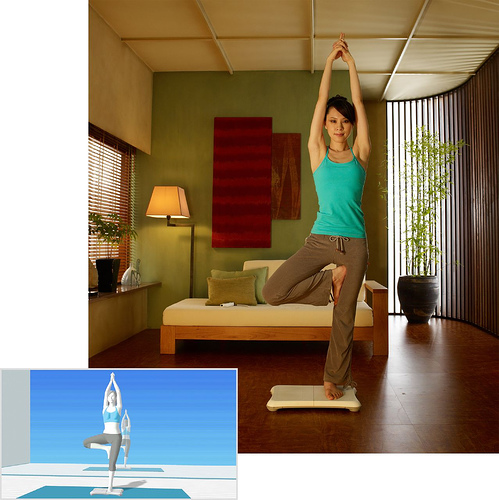 The speculation and discussion has already started in around the WiiFit Balance Board it seems, with Square/Enix, of all companies, expressing interest in the peripheral today. And that’s to be expected; it didn’t take a video games genius last week to see that there was massive potential beyond WiiFit’s mini-games and BMI indexing abilities.
The speculation and discussion has already started in around the WiiFit Balance Board it seems, with Square/Enix, of all companies, expressing interest in the peripheral today. And that’s to be expected; it didn’t take a video games genius last week to see that there was massive potential beyond WiiFit’s mini-games and BMI indexing abilities.
Button-less, hands-free strafing in FPS games? Skateboarding/snowboarding balance? A balance mechanic in fighting games? Full contact Yoga?!
The thing is, Square is a great company, and I’m sure they’ll do something with the balance board. That said, however, I think the “right developer” for the board is one that technically doesn’t exist yet.
Let me begin by saying I think that the major players are the wrong market for games that can fully utilize the balance board as a control mechanism, and therefore make it a successful peripheral (see past failures: Virtual Boy).
Sure, there will be the Square/Enix’s of the world that put out original IP that use the board, but I think in these cases the peripheral will be implemented much in the same way as the DS microphone. That is, poorly, and to the point where it’s become widely accepted as a major hindrance to gameplay (see also: inflating balloons in Mario Kart DS). It won’t be a central game controlling mechanic. That’s a bad thing for the balance board.
This is because of the simple fact that the balance board is an accessory, and will therefore never boast the same size user base as the system itself. For publishers and developers, this means an additional risk on top of the normal risks associated with making video games. What this means to you, the end user, or gamer, is a watered down, low risk project that has been handed down from higher ups to the lowest common denominator of the development studio to shave costs and reduce that risk. It’s simple business 101.
However, there’s a perfect outlet for some great Wii balance board games that already exists on the console: WiiWare.
Having WiiWare developers shoulder the majority of 3rd party games for the balance board does two things. First, the costs involved with developing a WiiWare title are already bare bones, so the risk is lower. This means we might actually see some pretty amazing, albeit simpler games developed exclusively for the balance board (or that at least utilize the board for integral control functions).
Second, this scenario creates a base from which larger developers can field ideas or even acquire these smaller companies. Either way, it reduces the apprehension developers might have about developing a game that requires a peripheral to work properly — as opposed to, say, bolting optional motion controls onto a PS3 game.
And the best part is — at least for the early WiiWare developers — is that when the Wii Balance Board launches sometime in 2008 and is snatched up en masse by non-traditional gamers (and some hardcore — just you watch), they’ll have a healthy installed base of at least a million or so users to work with.
